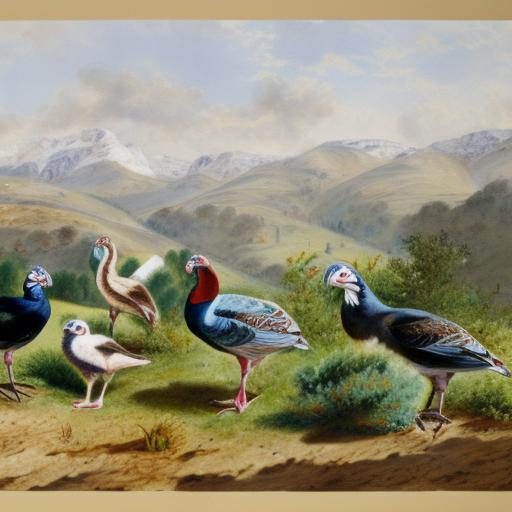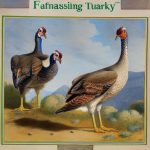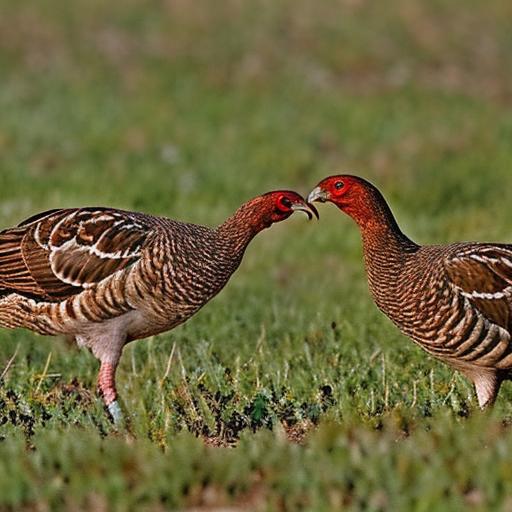Turkey breeds have been an integral part of human civilization for centuries, providing both meat and eggs for consumption. There are various breeds of turkeys, each with its own unique characteristics and traits. These breeds can be categorized into heritage breeds, broad-breasted breeds, rare and endangered breeds, commercially raised breeds, and wild turkey species. Understanding the differences between these breeds is essential for anyone looking to raise turkeys for meat or as pets.
Key Takeaways
- Turkey breeds come in a variety of types, each with its own unique characteristics and history.
- Heritage breeds of turkey are traditional breeds that have been around for centuries and are known for their rich flavor and unique appearance.
- Broad breasted breeds of turkey are popular in commercial production due to their fast growth and large breast size.
- Rare and endangered turkey breeds are at risk of extinction and efforts are being made to preserve and protect these unique breeds.
- Commercially raised turkey breeds are specifically bred for mass production and are commonly found in supermarkets and grocery stores.
- Wild turkey species are the ancestors of domesticated turkeys and can be found in the wild across North America.
- In conclusion, there is a wide variety of turkey breeds, each with its own unique characteristics and history, from heritage breeds to commercially raised breeds and even wild turkey species.
Heritage Breeds of Turkey
Heritage turkey breeds are known for their rich history and genetic diversity. These breeds have been around for centuries and are often raised for their flavorful meat and ability to thrive in free-range environments. Some popular heritage turkey breeds include the Bourbon Red, Narragansett, and Standard Bronze. These breeds are known for their ability to forage for food and their natural instincts for breeding and raising young. They are also prized for their unique plumage and ability to adapt to various climates. Heritage turkey breeds are often favored by small-scale farmers and homesteaders who value genetic diversity and sustainable farming practices.
On the other hand, heritage turkey breeds are also known for their slower growth rates and smaller breast sizes compared to commercial breeds. This makes them less desirable for large-scale commercial production but highly sought after by consumers who appreciate the superior flavor and texture of heritage breed turkey meat. Additionally, heritage turkey breeds are known for their ability to reproduce naturally, making them a valuable asset for preserving genetic diversity within the turkey population.
Broad Breasted Breeds of Turkey
Broad-breasted turkey breeds have been selectively bred for their large breast size and rapid growth rates, making them the preferred choice for commercial turkey production. These breeds include the Broad Breasted White and Broad Breasted Bronze, which are known for their fast growth and high meat yield. Broad-breasted turkeys are typically raised in confinement and fed a high-protein diet to promote rapid muscle development. This results in a larger breast size, which is the most desirable part of the turkey for meat production.
While broad-breasted turkey breeds are favored for their high meat yield and rapid growth, they are also known for their susceptibility to health issues such as heart problems and leg deformities due to their rapid growth rates. Additionally, these breeds are often unable to reproduce naturally and require artificial insemination for breeding purposes. Despite these drawbacks, broad-breasted turkey breeds remain the most popular choice for commercial turkey production due to their high meat yield and efficient growth rates.
Rare and Endangered Turkey Breeds
Rare and endangered turkey breeds are facing the threat of extinction due to declining population numbers and lack of conservation efforts. These breeds often have unique genetic traits and historical significance, making them valuable for preserving genetic diversity within the turkey population. Some rare and endangered turkey breeds include the Jersey Buff, Royal Palm, and White Holland. These breeds are known for their distinctive plumage and ability to thrive in free-range environments.
Conservation efforts are crucial for preserving rare and endangered turkey breeds, as they play a vital role in maintaining genetic diversity within the turkey population. Organizations such as the Livestock Conservancy work to raise awareness about the importance of preserving rare and endangered turkey breeds and provide resources for breeders and farmers to help conserve these valuable genetic resources.
Commercially Raised Turkey Breeds
Commercially raised turkey breeds are specifically bred for efficient meat production and rapid growth rates to meet the demands of the commercial market. These breeds include the Hybrid Converter and Hybrid Standard, which are known for their high meat yield and efficient growth rates. Commercially raised turkey breeds are typically raised in confinement and fed a high-protein diet to promote rapid muscle development.
Commercially raised turkey breeds are favored for their ability to produce large quantities of meat in a short amount of time, making them the preferred choice for large-scale commercial production. However, these breeds are also known for their susceptibility to health issues such as heart problems and leg deformities due to their rapid growth rates. Additionally, commercially raised turkey breeds often require artificial insemination for breeding purposes, as they are unable to reproduce naturally.
Wild Turkey Species

Wild turkey species are native to North America and are known for their distinctive plumage and elusive nature. There are six subspecies of wild turkeys, including the Eastern, Osceola, Rio Grande, Merriam’s, Gould’s, and Ocellated turkeys. These wild turkey species are highly adaptable and can be found in a variety of habitats, including forests, grasslands, and swamps.
Wild turkey populations have faced significant declines in the past due to habitat loss and overhunting, but conservation efforts have helped restore their numbers in many areas. Hunting regulations and habitat conservation efforts have played a crucial role in protecting wild turkey populations and ensuring their long-term survival.
Conclusion and Summary of Turkey Breeds
In conclusion, there is a wide variety of turkey breeds with unique characteristics and traits that cater to different purposes such as meat production, genetic diversity preservation, or conservation efforts. Understanding the differences between heritage breeds, broad-breasted breeds, rare and endangered breeds, commercially raised breeds, and wild turkey species is essential for anyone looking to raise turkeys for meat or as pets.
Heritage turkey breeds are known for their rich history and genetic diversity, making them a valuable asset for small-scale farmers and homesteaders who value sustainable farming practices. On the other hand, broad-breasted turkey breeds are favored for their large breast size and rapid growth rates, making them the preferred choice for commercial turkey production despite their susceptibility to health issues.
Rare and endangered turkey breeds play a vital role in maintaining genetic diversity within the turkey population, making conservation efforts crucial for preserving these valuable genetic resources. Commercially raised turkey breeds are specifically bred for efficient meat production and rapid growth rates to meet the demands of the commercial market but also face health issues due to their rapid growth rates.
Finally, wild turkey species are native to North America and are known for their distinctive plumage and elusive nature. Conservation efforts have helped restore wild turkey populations in many areas, ensuring their long-term survival. Overall, understanding the unique characteristics of each turkey breed is essential for making informed decisions when it comes to raising turkeys for various purposes.
If you’re interested in learning about different turkey breeds, you might also want to check out an article on Poultry Wizard that discusses the various factors to consider when choosing a chicken coop trampoline. This informative piece provides valuable insights into creating an engaging and safe environment for your chickens. You can read more about it here.
FAQs
How many turkey breeds are there?
There are approximately 6 recognized breeds of turkeys in the United States, including the Broad Breasted White, Broad Breasted Bronze, Bourbon Red, Narragansett, White Holland, and Beltsville Small White.
Are there other turkey breeds outside of the United States?
Yes, there are several other turkey breeds found in different parts of the world, including the Royal Palm, Slate, Black Spanish, and Midget White.
What are the differences between the various turkey breeds?
The different turkey breeds vary in size, color, and characteristics. Some are known for their meat production, while others are prized for their unique plumage.
Are all turkey breeds suitable for meat production?
While some turkey breeds are specifically bred for meat production, others are more commonly raised for their ornamental qualities or as pets.
Can all turkey breeds be raised for commercial purposes?
Not all turkey breeds are suitable for commercial production. Some breeds are better suited for small-scale or backyard farming, while others are specifically bred for large-scale commercial operations.
Meet Walter, the feathered-friend fanatic of Florida! Nestled in the sunshine state, Walter struts through life with his feathered companions, clucking his way to happiness. With a coop that’s fancier than a five-star hotel, he’s the Don Juan of the chicken world. When he’s not teaching his hens to do the cha-cha, you’ll find him in a heated debate with his prized rooster, Sir Clucks-a-Lot. Walter’s poultry passion is no yolk; he’s the sunny-side-up guy you never knew you needed in your flock of friends!







